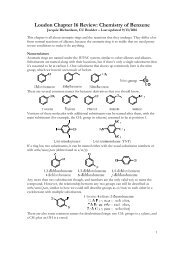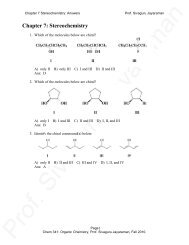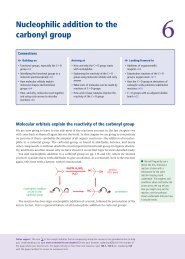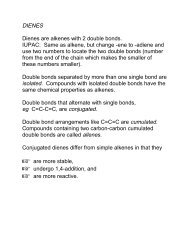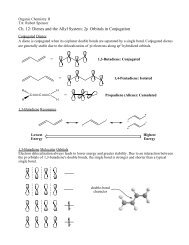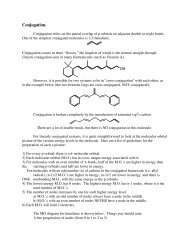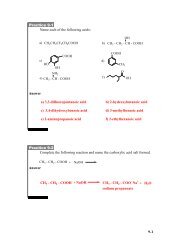<strong>Palladium</strong>-<strong>Catalyzed</strong> <strong>Cross</strong>-<strong>Coupling</strong>AngewandteChemiewhich, <strong>to</strong>day, is a highly promising C C bond formingreaction with application in industry. [166]4.3. Decarboxylative <strong>Coupling</strong> ReactionsThe original decarboxylative cross-coupling reaction wasreported by Nilsson in 1966 employing nearly s<strong>to</strong>ichiometricquantities of copper under harsh conditions (Scheme 31). [171]Almost 40 years later, Myers disclosed a catalytic processemploying palladium(II) salts, [172] and, in fur<strong>the</strong>r variants,o<strong>the</strong>r researchers showed that <strong>the</strong> organometallic componentmay be generated in situ from a carboxylic acid by, forexample, <strong>the</strong> action of an additional metal (Scheme 32) [173] oran additive, such as nBu 4 NCl. [174]reagents, <strong>the</strong> only by-product is H 2 , and <strong>the</strong> term high a<strong>to</strong>meconomymay be used without embarrassment. This dream israpidly and undeniably becoming reality, as numerousresearch groups are recognizing <strong>the</strong> opportunities <strong>to</strong> developnew syn<strong>the</strong>tic methods by processes given <strong>the</strong> umbrella titleof C H activation. The first hint in <strong>the</strong> literature concerningsuccessful C H activation reactions predate <strong>the</strong> palladiummediatedcross-couplings. Thus, in 1963 Kleiman and Dubeckreported <strong>the</strong> isolation of a nickel Cp complex (Cp = C 5 H 5 )resulting from ortho C H activation of azobenzene formed by<strong>the</strong> action of s<strong>to</strong>ichiometric quantities of nickel(Scheme 33). [175] Shortly after, Chatt and Davidson notedScheme 31. The first examples of <strong>the</strong> decarboxylative cross-coupling[171, 172]reaction.Compared <strong>to</strong> <strong>the</strong> complementary C H activation methodologydiscussed below, <strong>the</strong> decarboxylative coupling doesnot suffer from regioselectivity issues since <strong>the</strong> site forcoupling is predefined. The elevated temperatures for <strong>the</strong>reaction, availability of benzoic acid derivatives, and functional-group<strong>to</strong>lerance need <strong>to</strong> be addressed for fur<strong>the</strong>revolution of <strong>the</strong> decarboxylative coupling as a competingcoupling methodology. The interested reader is referred <strong>to</strong><strong>the</strong> Review by Goossen [173b] for a detailed account of this<strong>to</strong>pic.4.4. C H Activation Reactions<strong>the</strong> equilibrium of a ru<strong>the</strong>nium naphthalene species between<strong>the</strong> p-complex and <strong>the</strong> C H insertion complex. [176] In fact, CH activation had successfully moved in<strong>to</strong> <strong>the</strong> catalytic realmeven before <strong>the</strong> discovery of catalytic palladium-mediatedcross-coupling. This is evidenced by <strong>the</strong> work of Fujiwarawho, in 1969, reported on <strong>the</strong> oxidative Heck reaction [177] twoyears before <strong>the</strong> initial disclosures of Heck and Mizoroki.Following <strong>the</strong>se early results, C H activation has witnesseda surge of activity in <strong>the</strong> last 20 years, pioneered by <strong>the</strong>contributions of Murai and his school, using ru<strong>the</strong>niumcatalysis. [178] Bergman and Graham initiated <strong>the</strong> quest for<strong>the</strong> “holy grail” of cross-coupling, investigating alternativemetals for <strong>the</strong>se transformations. [179] Today, <strong>the</strong> direct C Hactivation wave employing palladium catalysis stimulated byresults from <strong>the</strong> labora<strong>to</strong>ries of Du Bois, Fagnou, [180] Gaunt,Hartwig, Miura, Sanford, Yu, among o<strong>the</strong>rs, are pushing <strong>the</strong>boundaries of <strong>the</strong> probable and possible. [181] We will leave this<strong>to</strong>pic here at <strong>the</strong> origins and developments, and refer <strong>the</strong>reader <strong>to</strong> Reviews in <strong>the</strong> rapidly evolving C H activation[182, 183]area.Scheme 33. Early C H activation processes. [175–177]Scheme 32. The Pd–Cu catalyzed decarboxylative cross-coupling reaction.[173]A dream of organic chemists has been <strong>the</strong> discovery ofcoupling reactions with no prefunctionalization of <strong>the</strong> couplingpartners. In o<strong>the</strong>r words, imagine a route which avoids<strong>the</strong> use of aryl halides or pseudohalides and organometallic5. Industrial ApplicationsIn organic syn<strong>the</strong>sis methodology, <strong>the</strong> ultimate testimonyof value is utility. The <strong>Nobel</strong> <strong>Prize</strong> winning Heck, Suzuki, andAngew. Chem. Int. Ed. 2012, 51, 5062 – 5085 2012 Wiley-VCH Verlag GmbH & Co. KGaA, Weinheim www.angewandte.org5079
Angewandte .ReviewsNegishi coupling chemistries, alongside <strong>the</strong> o<strong>the</strong>r discoveriesand technologies outlined above, amply substantiate thismaxim. Thus, syn<strong>the</strong>ses of natural products and drug moleculesabound where <strong>the</strong> key step(s) consists of metalcatalyzedcross-coupling reactions as selectively exemplifiedby <strong>the</strong> well-established BMS (originally Dupont–Merck)syn<strong>the</strong>sis of Losartan, [184] <strong>the</strong> Merck Singulair process (aHeck coupling involving isomerization of an allylic alcohol),[185] and <strong>the</strong> <strong>to</strong>tal syn<strong>the</strong>sis of discodermolide by Smith(Negeshi coupling) and later Novartis (Suzuki coupling;Scheme 34). [186] Examples are continuously appearing, such as<strong>the</strong> Novartis route <strong>to</strong> Gleevec (Imatinib) which employsa Buchwald–Hartwig amination as <strong>the</strong> key step. [187] Manleyand co-workers have demonstrated large-scale Corriu–Kumada and Negishi couplings in <strong>the</strong> syn<strong>the</strong>sis of PDE472,a potential drug for <strong>the</strong> treatment of asthma. [189] Pfizersprocess for <strong>the</strong> production of a hepatitis C polymeraseinhibi<strong>to</strong>r incorporates a Heck reaction carried out on 40 kgscale. [188] In a very recent report, Koning and co-workersprovide an example of a Suzuki–Miyaura coupling on a 50 kgscale in <strong>the</strong> syn<strong>the</strong>sis of Crizotinib, a potent anti-canceragent. [190] A large number of Reviews published on <strong>the</strong>Scheme 34. <strong>Cross</strong>-coupling reactions in <strong>to</strong>tal syn<strong>the</strong>sis. [184–190]T. J. Colacot, V. Snieckus et al.application of cross-coupling methodologies in <strong>to</strong>tal syn<strong>the</strong>sis[191] reflect <strong>the</strong> fertile evolution of <strong>the</strong> subject and <strong>the</strong>obvious revolution that <strong>the</strong>se methodologies have broughtabout for natural-product and drug-molecule syn<strong>the</strong>sis forwhich <strong>the</strong> <strong>2010</strong> <strong>Nobel</strong> <strong>Prize</strong> has been fittingly awarded.6. <strong>Coupling</strong> Reactions: Unsolved Problems,Challenges, and OutlookDespite <strong>the</strong> many significant discoveries and developmentssince <strong>the</strong> first reports of transition-metal-catalyzedorganic transformations, <strong>the</strong>re remain, as expected in <strong>the</strong>incremental waves of scientific progress, numerous unsolvedproblems. Thus, only partial success in C(sp 3 ) C(sp 3 ) andC(sp 2 ) C(sp 3 ) cross-coupling reactions involving alkyl halideshas been achieved. Fur<strong>the</strong>r, achievement of selective mono a-arylation requires effort in cases where <strong>the</strong> product of <strong>the</strong>reaction can partake in secondary coupling (e.g., a-arylationof CH 3 COR and arylation of primary amines). In <strong>the</strong> area ofasymmetric catalysis, although simple methods using chiralligands <strong>to</strong> form enantioenriched products have been developed,fundamental studies are essential <strong>to</strong> achieve practicaland hence widely applied methodology. Finally, determinationof <strong>the</strong> mechanism is essential for successful use insyn<strong>the</strong>sis. Thus, although <strong>the</strong> steric and electronic effects of<strong>the</strong> ligands involved in <strong>the</strong> various steps of <strong>the</strong> catalytic cycleare now reasonably well rationalized, <strong>the</strong>re remains, in manycases, a lack of understanding of <strong>the</strong> mechanism of formationof <strong>the</strong> active Pd 0 catalytic species from preformed Pd IIcomplexes. The newest wave of C H activation reactionswill increasingly find advantages by <strong>the</strong> use of alternativemetals, such as ru<strong>the</strong>nium, iridium, and—<strong>the</strong> oldest catalyticmetal—copper. To predict whe<strong>the</strong>r or not palladium willalways be <strong>the</strong> metal of choice is, as always in scienceprognosis, a treacherous undertaking. For now, <strong>the</strong> future ofpalladium is bright since, in a vast array of conditions fora multitude of disconnections, <strong>the</strong> unique qualities ofpalladium are demonstrable, serving only <strong>to</strong> reinforce itspower especially in C C bond construction.To conclude, gigantic progress has been achieved in <strong>the</strong>last 40 years within <strong>the</strong> palladium-catalyzed cross-couplingfield using functionalized leaving group and metal couplingpartners. Assessed by recent developments, <strong>the</strong> increasingfocus on <strong>the</strong> development of direct C H activation processeswill become <strong>the</strong> next prevailing wave of reactions forsyn<strong>the</strong>sis. This reaction also awaits <strong>the</strong> development ofmore practical and economical conditions and proceduresfor application in large-scale syn<strong>the</strong>ses whilst finding robustsolutions <strong>to</strong> <strong>the</strong> selectivity issues encountered for lessstraightforwardcoupling partners. The sometime expressednotion that <strong>the</strong> market is becoming saturated with catalystsand methods for coupling reactions can easily be dismissed byano<strong>the</strong>r observation by Woodward who, in 1969, noted thatcomments such as “… well, now you have shown thatanything can be syn<strong>the</strong>sized, so <strong>the</strong> field has had it…” werecommon place. [146] Three <strong>Nobel</strong> <strong>Prize</strong>s in Chemistry forhomogeneous catalysis during <strong>the</strong> last decade, [192] culminatingwith <strong>the</strong> <strong>2010</strong> <strong>Nobel</strong> prize for palladium-catalyzed cross-5080 www.angewandte.org 2012 Wiley-VCH Verlag GmbH & Co. KGaA, Weinheim Angew. Chem. Int. Ed. 2012, 51, 5062 – 5085



